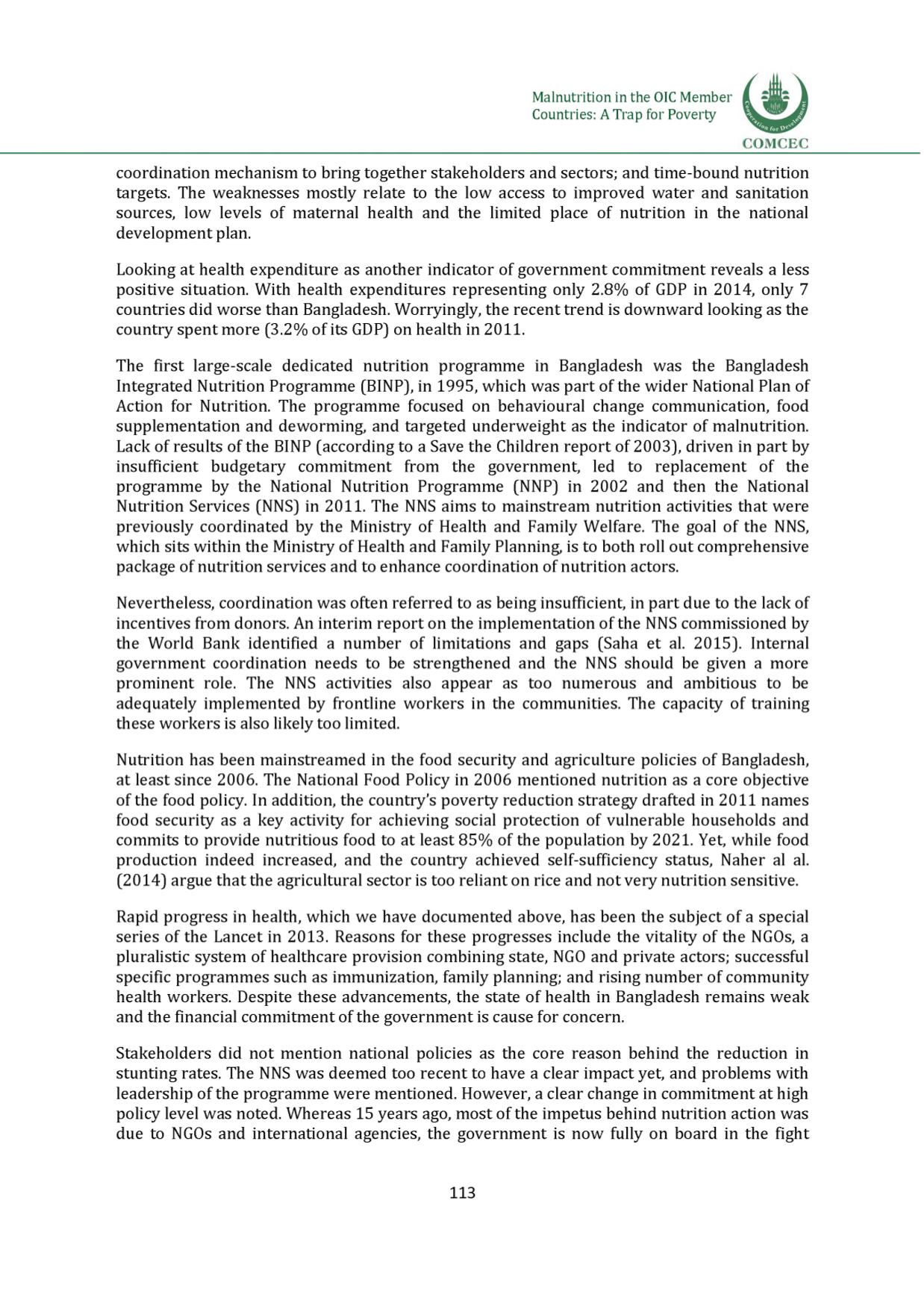

Malnutrition in the OIC Member
Countries: A Trap for Poverty
coordination mechanism to bring together stakeholders and sectors; and time-bound nutrition
targets. The weaknesses mostly relate to the low access to improved water and sanitation
sources, low levels of maternal health and the limited place of nutrition in the national
development plan.
Looking at health expenditure as another indicator of government commitment reveals a less
positive situation. With health expenditures representing only 2.8% of GDP in 2014, only 7
countries did worse than Bangladesh. Worryingly, the recent trend is downward looking as the
country spent more (3.2% of its GDP] on health in 2011.
The first large-scale dedicated nutrition programme in Bangladesh was the Bangladesh
Integrated Nutrition Programme (BINP), in 1995, which was part of the wider National Plan of
Action for Nutrition. The programme focused on behavioural change communication, food
supplementation and deworming, and targeted underweight as the indicator of malnutrition.
Lack of results of the BINP (according to a Save the Children report of 2003], driven in part by
insufficient budgetary commitment from the government, led to replacement of the
programme by the National Nutrition Programme (NNP) in 2002 and then the National
Nutrition Services (NNS) in 2011. The NNS aims to mainstream nutrition activities that were
previously coordinated by the Ministry of Health and Family Welfare. The goal of the NNS,
which sits within the Ministry of Health and Family Planning, is to both roll out comprehensive
package of nutrition services and to enhance coordination of nutrition actors.
Nevertheless, coordination was often referred to as being insufficient, in part due to the lack of
incentives from donors. An interim report on the implementation of the NNS commissioned by
the World Bank identified a number of limitations and gaps (Saha et al. 2015]. Internal
government coordination needs to be strengthened and the NNS should be given a more
prominent role. The NNS activities also appear as too numerous and ambitious to be
adequately implemented by frontline workers in the communities. The capacity of training
these workers is also likely too limited.
Nutrition has been mainstreamed in the food security and agriculture policies of Bangladesh,
at least since 2006. The National Food Policy in 2006 mentioned nutrition as a core objective
of the food policy. In addition, the country's poverty reduction strategy drafted in 2011 names
food security as a key activity for achieving social protection of vulnerable households and
commits to provide nutritious food to at least 85% of the population by 2021. Yet, while food
production indeed increased, and the country achieved self-sufficiency status, Naher al al.
(2014] argue that the agricultural sector is too reliant on rice and not very nutrition sensitive.
Rapid progress in health, which we have documented above, has been the subject of a special
series of the Lancet in 2013. Reasons for these progresses include the vitality of the NGOs, a
pluralistic system of healthcare provision combining state, NGO and private actors; successful
specific programmes such as immunization, family planning; and rising number of community
health workers. Despite these advancements, the state of health in Bangladesh remains weak
and the financial commitment of the government is cause for concern.
Stakeholders did not mention national policies as the core reason behind the reduction in
stunting rates. The NNS was deemed too recent to have a clear impact yet, and problems with
leadership of the programme were mentioned. However, a clear change in commitment at high
policy level was noted. Whereas 15 years ago, most of the impetus behind nutrition action was
due to NGOs and international agencies, the government is now fully on board in the fight
113
















